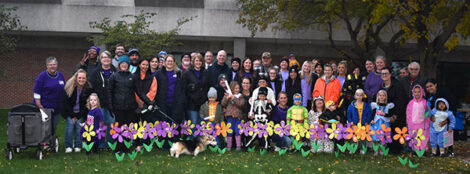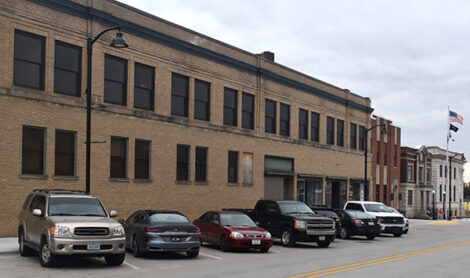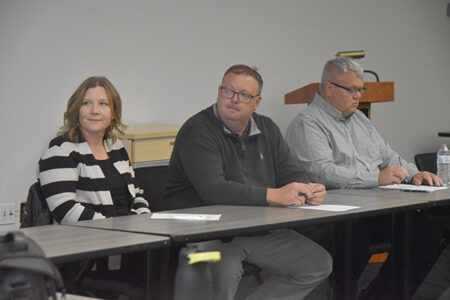Brad Wilkening presents ‘Lessons from the Holocaust’ at Melbourne Public Library

Brad Wilkening
MELBOURNE – Brad Wilkening, an Iowa native, teacher, and coach, presented a program called “Lessons of the Holocaust” at the Melbourne Public Library on Friday evening, July 11. Wilkening developed a Holocaust course for high school students after training at the Illinois Holocaust Museum. He further expanded his expertise through programs at Columbia University and the Jewish Foundation for the Righteous. He has been a member of the Iowa Commission on Holocaust Education since 2014 and shares his knowledge with schools and libraries across Iowa.
A series of posters in the meeting room illustrated the stories of sixteen people who displayed “Social Responsibility, Courage, Self Sacrifice, Cooperation, Compassion, Ingenuity, Integrity, and Moral Leadership” during the Holocaust. Most are not well-known for their heroism despite saving thousands of lives, but one name is known to many and stood out: Oskar Schindler.
The presentation began with two common misconceptions about the Holocaust: 1.) that the U.S. did not know about it at the time, and 2.) the belief that that “it can’t happen again.” Wilkening explained that President Franklin D. Roosevelt did, in fact, know what was happening to the Jewish people in Europe, and that the Holocaust has, indeed, happened again. Genocide has occurred and is ongoing in numerous nations around the world.
Exploring how the world could allow the Holocaust to happen, Wilkening zeroed in on post-WWI Germany between 1921 and 1933. The Treaty of Versailles was signed in 1919 and formally ended WWI. It imposed harsh penalties on Germany, which caused resentment there and fueled the rise of extremism. This led to the rise of Adolf Hitler and the Nazi Party, and to WWII and the Holocaust.
The Weimar Constitution of 1919 established Germany as a democratic republic with an elected president. In 1923, Adolf Hitler made a failed attempt to take control of the government in what is called the “Beer Hall Putsch.”
Paul von Hindenburg, regarded as a war hero by Germans, was elected president in 1925. The German parliament was burned down in 1933 by unknown persons. This was a key event, contributing to the eventual establishment of the Nazi dictatorship.
In addition, massive inflation struck Germany after WWI, at a level we have never experienced in the U.S. Hindenburg attempted to fix this by printing more money, but it ended up worthless. This created dire financial circumstances for the German people.
To maintain power over the next few years, Hindenburg named Hitler to the high government position of Chancellor in 1933. This was a perfect example of the theory, “keep your friends close and your enemies closer.” Also in 1933, the “Enabling Act” became law, greatly increasing Hitler’s power as Chancellor. This act allowed Hitler to bypass the democratic process and the President, and rule by decree. Effectively, this dismantled the Weimar Republic.
In 1934, Hindenburg died, and Hitler assumed power, merging the offices of president and chancellor, and naming himself as “Fuehrer.” He then had complete control of the government. In 1935, the Nuremburg Laws were passed. These antisemitic and racist laws were the start of the dehumanization and persecution of Jewish people and mixed-race Germans.
Next came the infamous 1938 “Kristallnacht,” or the “Night of Broken Glass,” when paramilitary forces conducted a wave of violence against Jews, their homes and businesses, and their synagogues. This marked the effective beginning of the Holocaust, and Nazi propaganda spread throughout the country, vilifying Jews, and others.
Initial attempts to “disinfect” Germany of the Jewish “problem” meant using bullets. A printed chart even illustrated the cost of the bullets used to eliminate over 70,000 Jews in 1940 and 1941. This led to the search for more efficient methods. Ghettos were established in Poland and elsewhere. 450,000 Jews were restricted to barely over one square mile in Warsaw. Disease and starvation killed thousands, and many more were eventually transported to camps: the able-bodied to work camps, and those who were not, to extermination camps.
Wilkening described the options that Jews had during that time as “Choiceless Choices.” These were to leave the ghetto, to try to pass as Aryan, to go into hiding, or to go east or west out of Germany. None of these were easy, and many Jews “clung to the false hope that, as bad as things were, they would not get worse.”
In 1942, the German government coordinated the “Final Solution to the Jewish Problem” at the Wannsee Conference. The Holocaust became an official policy, and the wholesale genocide of millions of Jews and other undesirable people began.
Wilkening got to know many Holocaust survivors during his studies and became close friends with them. He shared the stories of seven of these friends, who experienced horrendous conditions in the camps or while hiding: a life of fear, starvation, disease, and family deaths.
The program ended with a reminder that we all play roles in events such as the Holocaust. We can choose to be perpetrators, collaborators, victims, bystanders, or “upstanders”–those who choose the courage to do the right thing despite huge risks. “Bullying and indifference start at an early age, and we have a responsibility to help create a safer more caring environment. My goal is to keep the lessons of the Holocaust alive.” Wilkening’s purpose, he said, is to spread goodness and kindness and encourage humanity in the world.






